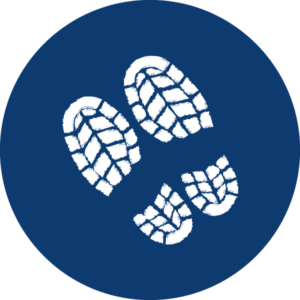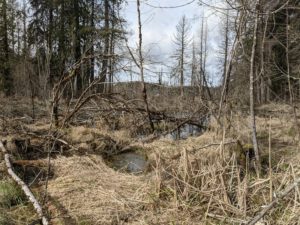 Your Mission…
Your Mission…
Millersylvania State Park is a mix of wetlands and old growth forests, home to numerous wildlife. Find and photograph evidence of pileated woodpeckers to send to us! What to look for? Rectangular holes in trees where these woodpeckers hunt for ants to eat.
When you arrive at the park, follow the signs to the boat launch. Park in the boat launch lot. The trail is at the beginning of the parking lot on your right.
NOTE: A Discover Pass is needed to complete this mission and depending on the season, rubber boots might come in handy as trails can be muddy during wet weather.
![]()

 Welcome to Millersylvania State Park
Welcome to Millersylvania State Park
Millersylvania State Park is a mix of wetlands and old growth forests. Our trail starts with a board walk through the wetland. Since it is a wetland with wet soils and a lot of water you will find the trail muddy here many times of the year. Keep a look out for little handprint-like tracks in the mud. These are racoon tracks!
Raccoon have five toes that resemble a human hand. The front print is smaller (1-3″) and has a C-shaped heel pad, while the rear print has a longer (1.5-4″) heel pad.
 Wetland Habitat
Wetland Habitat
As the wetland opens up into the larger ponded water keep an eye out for beaver and muskrat!
![]()
 Forest Trail
Forest Trail
Take the trail to the right into the forest. Put your sleuth hats on and keep an eye out for past reminders of logging. Logging occurred in this forest over 100 years ago.
Do you see any evidence of logging?
Once, old giant cedar trees filled these woods. See how many of their decaying stumps and fallen trees you can find. These are called nurse trees or nurse stumps because they provide nurseries for seeds to grow little trees. They are also very important for adding nutrients to the soil and they provide homes for small animals, such as salamanders!
You can also see large rotting stumps and logs with shrubs and trees growing from them. Similarly, these are called nurse stumps or nurse logs. The tops of the stumps often have red huckleberry and salal growing from their tops. Please do not climb on or harm dead trees or stumps as they are an important missing habitat in our forests.

 Woodpecker Evidence
Woodpecker Evidence
Stay on the lookout for rectangular holes in the trees. These holes were made by a pileated woodpecker! We can determine this by looking at the patter of the holes. They make a hole with a rectangular pattern instead of round.
FACT!
The pileated woodpecker is one of the biggest, most striking forest birds on the continent. It is nearly the size of a crow, black with bold white stripes down the neck and a flaming-red crest. Look and listen for the pileated woodpeckers call or drumming on dead trees and fallen logs in search of their main prey carpenter ants. As the excavate for prey they leave unique rectangular holes in the wood. The nest holes these birds make offer crucial shelter to many species including swifts, owls, ducks, bats, and pine martens.
Did you know?
Smaller birds like chickadees and wrens can use a woodpecker hole for a nesting site.
Why do some of these trees look healthy and yet have woodpecker holes? Look closely into the holes. You can see that the core or “heart” of the trees are sponge-like. They have heartwood rot disease, a fungal disease that causes decay of the wood in the center of the tree’s trunk and branches. Pretty smart bird to know when a tree has disease!

 Even More Woodpecker Evidence
Even More Woodpecker Evidence
Continue down the trail and see if you can find any more woodpecker holes along the way.
Why do woodpeckers drill into trees?
The most common reasons woodpeckers use their beaks to create holes in trees is to look for food. Woodpeckers eat insect larvae that are found beneath the surface of tree bark.
In the spring, woodpeckers make even more noise as they use their drilling sounds to attract a mate and to establish their territory. In these instances, they choose objects for the resonant sounds that they make – you might hear one on a metal pole or on a metal gutter, for instance. This unique form of communication is referred to as “drumming,” and is used by both male and female woodpeckers.
Woodpeckers have two unique adaptations, their long curled tongue for feeding and a reinforced skull to compensate for banging their heads against trees. For more info visit https://www.dkfindout.com/us/animals-and-nature/birds/woodpeckers-skull/ and https://theconversation.com/how-do-woodpeckers-avoid-brain-injury-120489
Also, in the spring, woodpeckers will drill into dead or dying trees to create nests. While woodpeckers create small holes when feeding, the holes created for nesting will be much larger. For the pileated woodpecker, they need a large tree hole for a nest as they are a very big bird of 16-19 inches!
![]()
 More Wetland Habitat
More Wetland Habitat
As you continue along the trail, you will walk over a boardwalk through and near a very large steam fed, open-water wetland. Be sure to keep to the right when the trail forks.
What is a wetland?
Wetlands are areas where the land does not drain well and is covered by water all or part of the year. Wetlands have different names based on their function and the types of plants they grow. There are four categories called marshes, swamps, bogs and fens.
The soils and plants in a wetland are different than those where it is dry. Plants growing in and near are water-loving plants called hydrophytes. Wetland soils are referred to as hydric because when water covers the soils for long periods of time it has less oxygen in it or is anaerobic and sometimes it has a sulfur-like odor.
Wetlands are very important as they provide habitat for thousands of species of aquatic (water) and terrestrial (land) plants and animals. They also provide flood control, filter and clean water and store water in the ground (ground water or aquifer) that provides us with drinking water and our streams with water. Wetlands are also the worlds best ecosystems for capturing and storing carbon from CO2.
FACT!
Some water in wetlands and streams are brown in color resembling tea water. This is caused by tannins which are naturally occurring and come from trees and plants.
 What lives in a wetland?
What lives in a wetland?
If you are quiet and very lucky you may see beaver!
Beaver signs to look for:
- gnawed wood
- sticks and mud piled to make a dam
- beaver slides or trails entering the water
Beavers play a very important role in maintaining a healthy ecosystem and creating wetlands. Before Europeans came to North America it is estimated that there were 100-400 million beavers! Now there are only 6-12 million beaver. Can you imagine how having fewer beaver has changed our landscape and the storage of ground water?
Did you know?
Beavers are such incredible engineers that they are being used to restore streams and rivers.

 Back on the Trail
Back on the Trail
At the fork in the trail, keep right. There will be park trail maps. Follow them to the campsite area.
On the way, see if you can find places where birds and small animals can make their home. Look for holes in trees, broken topped trees, snags, rotten logs, holes in the ground or under tree roots.
Can you guess what animals live in these old growth forests that you are unlikely to see? HINT: They both come out at night!
They are the northern flying squirrel and little brown myotis- bats! Both animals are nocturnal and are a very import part of the old growth conifer forest ecosystem.
What about food? If you were an animal living in this forest what would you eat? Look for cones, seeds, mushrooms, plant tubers, berries, lichen and mice!

 Congratulations!
Congratulations!
You have completed your mission to find and photograph evidence of pileated woodpeckers! Don’t forget to login to the Goose Chase App and submit your photo for this mission to collect your park specific sticker!
As you exit the campground area, follow the sign that points to the BEACH trail.
This trail leads back to the lake and the public fishing area through the historic camp built in the 1930s by the Civilian Conservation Corps. The log structures were built from trees form the park.
To return to the parking lot, take the trail on the right.
